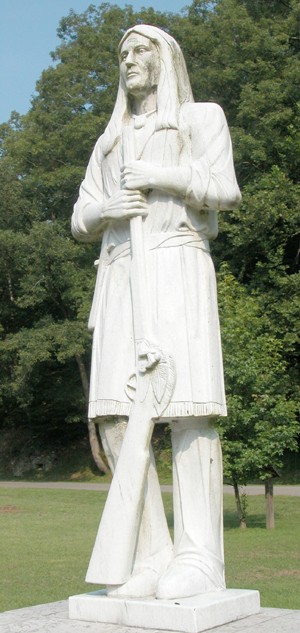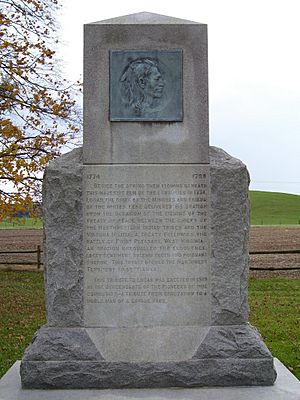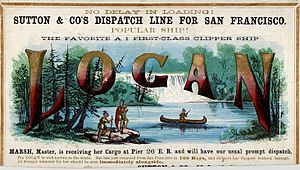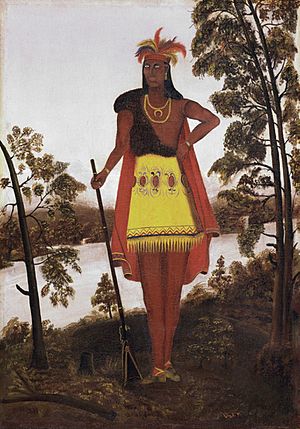Logan (Iroquois leader) facts for kids

Logan the Orator (born around 1723, died 1780) was a famous speaker and war leader from the Cayuga tribe. The Cayuga were one of the Six Nations of the powerful Iroquois Confederacy.
Logan became well-known for a speech called Logan's Lament. He reportedly gave this speech after a war. Historians still discuss some important details about Logan, like his original name and if he truly said every word of Logan's Lament.
Contents
Who Was Logan?
Experts agree that Logan was a son of Chief Shikellamy, a key diplomat for the Iroquois Confederacy. However, it's been debated which of Shikellamy's sons became Logan the Orator. He was known by several names, including Tah-gah-jute and Tachnechdorus.
Logan's father, Chief Shikellamy, was an Oneida leader. He worked closely with a Pennsylvania official named James Logan. To show respect, the young man who became Logan the Mingo took the name "James Logan."
Many Iroquois and other Native American groups moved to the Ohio Country (which is now parts of Ohio, West Virginia, Kentucky, and western Pennsylvania). They joined together and became known as the Mingo tribe. Logan is often called a Mingo "chief," but some historians say he was mainly a war leader, not a peace chief. Like his father, Logan usually got along well with the white settlers moving into the Ohio Country.
Logan's Life Story
Family and Early Years
Logan's father was Chief Shikellamy of the Oneida Tribe. His mother was Neanoma, a Cayuga woman. Children traditionally belonged to their mother's tribe, so Logan and his siblings were considered Cayuga.
Logan had several brothers and a sister. One of his brothers, James Logan, was later called "Logan, the Mingo." His brother Arahhot was killed in a war in 1744.
The Yellow Creek Attack
Logan's friendly feelings toward white settlers changed after a terrible event called the Yellow Creek Massacre. On April 30, 1774, a group of Virginia frontiersmen led by Daniel Greathouse attacked and killed several Mingo people. Among those killed were Logan's brother (known as John Petty) and at least two other close female relatives. About a dozen Mingo people died in total. Logan was not there when it happened, but he was called back to the area.
Logan Seeks Justice
Important tribal chiefs like Cornstalk (from the Shawnee) and White Eyes (from the Lenape) tried to make peace. They wanted to stop the attack from turning into a bigger war. However, Native American customs allowed Logan to get revenge for the murders.
Soon, groups of Mingo and Shawnee warriors, including one led by Logan, attacked frontier settlements. They killed settlers and took some as captives. One attack was known as the Spicer Massacre. The governor of Virginia, Lord Dunmore, responded by starting a military campaign against the Mingo and Shawnee. This conflict became known as Dunmore's War.
Logan's Famous Speech

Logan was not at the main battle of Dunmore's War, the Battle of Point Pleasant (October 10, 1774). After this battle, Lord Dunmore's army moved into the Ohio Country. They made the Ohio Indians agree to a peace treaty.
According to stories, Logan refused to attend the peace talks. Instead, he gave a powerful speech that became very famous:
I ask any white man to say if I ever let him leave my cabin hungry without giving him food, or cold and without clothes. During the last long and bloody war, I stayed peacefully in my cabin, wanting peace. I loved the white people so much that my own people would point at me and say, "Logan is a friend of the white men." I even thought about living with you, but then one man caused great harm. Colonel Cresap, last spring, cruelly attacked and killed all my relatives, even my women and children. Not a single drop of my family's blood flows in anyone alive today. This called for my revenge. I have sought it, and I have had my fill of vengeance. For my people, I am happy about the coming of peace. But do not think my joy comes from fear. Logan has never felt fear. He will not run away to save his life. Who is left to mourn for Logan? No one.
This speech was first printed in a newspaper in 1775. It became even more popular when Thomas Jefferson included it in his book Notes on the State of Virginia (1782). An American elm tree in Pickaway County, Ohio, where Logan was said to have given the speech, became known as the Logan Elm. It grew very large before it died in 1964.
Later Life and Passing
Not much is known about the rest of Logan's life. He continued to attack white settlers and joined with the British-allied Mohawks during the American Revolution. He died in a fight near Lake Erie in 1780.
Logan's Legacy
Many places are named after Logan, honoring his memory:
- Logan, Ohio
- Logan County, West Virginia (and the town of Logan, West Virginia within it)
- Chief Logan State Park, West Virginia
- Logan Elm High School is located near the state memorial.
- Fort Hill Cemetery in Auburn, New York, has a large monument for him.
- Chief Logan Reservation - a camp property in Ray, Ohio for the Boy Scouts of America.
- Logan Honors Program - at Fort Steuben Scout Reservation in Freeport, Ohio.
- At Indianola Junior High School in Columbus, Ohio, there is a sculpture of Logan with the name TAHGAHJUTE carved on it.

See also
 In Spanish: James Logan (mingo) para niños
In Spanish: James Logan (mingo) para niños


